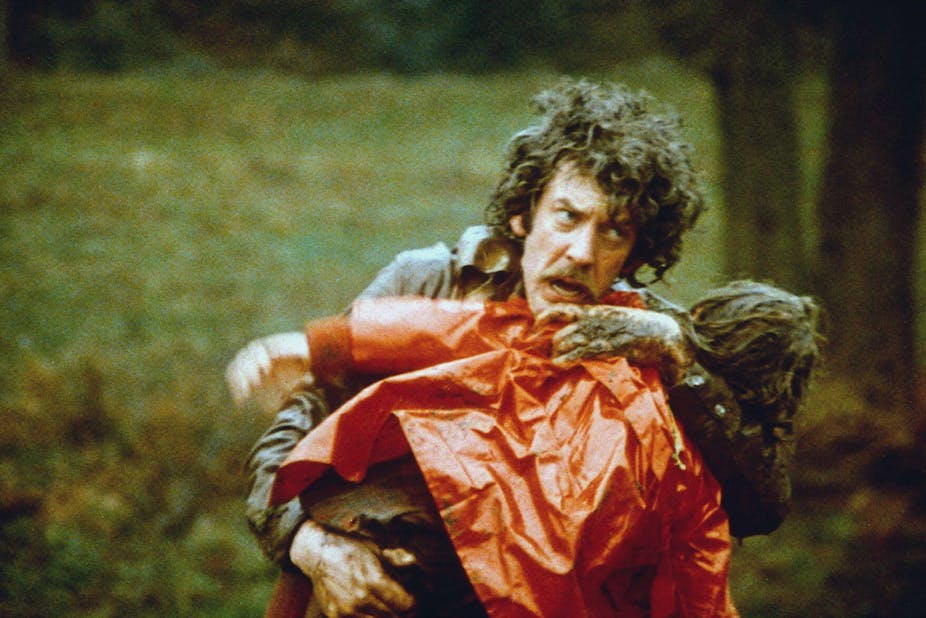Grief-stricken by the death of their daughter in a drowning accident, John Baxter (Donald Sutherland) and his wife Laura (Julie Christie) relocate temporarily to a wintry Venice, where he has been commissioned to restore the crumbling church of San Nicolò dei Mendicoli.
In a restaurant one day, melancholy Laura meets two sisters (Hilary Mason and Clelia Matania). One of them is a blind clairvoyant and claims to be able to see and communicate with her dead daughter, Christine. John is outwardly dismissive, even though he keeps catching sight of a child wearing a red coat similar to his daughter’s disappearing around corners and down alleyways across the misty, shadowy city.
At the same time, Venice has a killer on the loose. When their son has an accident at his English boarding school and Laura travels home to be with him, John is left behind to succumb to his delusions.
Adapted from Daphne du Marier’s supernatural short story and directed by Nicolas Roeg, Don’t Look Now is a moving and tender portrait of marriage and parental grief, as well as a haunting – and occasionally terrifying – horror film.
Fifty years on from its release in 1973, the film is a fixture in several “best of” lists: Best British film, best horror film, best film of the 1970s, even best film, period.
Venice sets the scene
Even those who haven’t seen Don’t Look Now will likely be familiar with its most striking images. The drowned little girl in the red mackintosh hauled from the pond by her father at the film’s beginning, the intimate and tender sex scene between John and Laura inter-cut with scenes of them getting ready for dinner afterwards – and its truly shocking ending.
There is also the sophisticated manner in which the film’s visual language melds seamlessly with its overarching tone. Off-season Venice functions as a bleak, grey canvas on which splashes of vivid red recur throughout – washing on a line, a glass candle holder, a painted door – reminding us constantly of Christine’s tragic death.
Consistent with the style of some of Roeg’s other films, Graeme Clifford’s editing transports us back and forth in time, often within the same sequence. This lends the film a disorientating quality akin to John’s journey through the city in pursuit of the child in the red coat.

There are portents of doom throughout. John nearly falls from the scaffolding to his death while inspecting a church mosaic and the candle Laura lights for Christine in the church blows out. John watches as a murdered woman – who has more than a passing resemblance to his wife – is pulled from the canal. He then later sees Laura with the two strange sisters, dressed in black on a funeral barge, even when we know she is on her way back to England. The water all around Venice reminds us of the tragedy that hangs over proceedings.
Creeping sense of dread
Does all this account for Don’t Look Now’s continued resonance with audiences and critics 50 years on? Perhaps. But it is also worth considering the film’s relationship to the horror genre.
Don’t Look Now was released in the same year as The Exorcist. Though the two have similarities, notably in their preoccupation with religious themes and iconography, The Exorcist became a more popular cultural phenomenon.
It spawned two sequels, a prequel, a television series and, starting this week with the release of The Exorcist: Believer (2023), a potential new trilogy of films that pick up from where the original left off. They can both reasonably claim to be (great) horror films, except The Exorcist was a blockbuster that spawned a franchise, and Don’t Look Now is an arthouse film that now stands on a pedestal of its own.

It’s helpful to consider Don’t Look Now’s enduring reputation in relation to a critical category that has become ubiquitous in recent years: “post-horror” films. Such films dispense with the jump scares and visceral gore generally associated with the genre to offer instead explorations of trauma and a creeping sense of dread that (supposedly) plays to more thoughtful and discerning viewers.
Post-horror films also don’t tend to spawn sequels or endless franchises, an aspect of the wider genre that has contributed to its status as one of the most commercially resilient but critically derided.
To describe a film as post-horror is to acknowledge the hierarchy that has long existed within the genre. This reveals the select few films deemed by critics to be worthy of their position alongside cinema’s other great works, and the apparent vast wasteland of repetitive, gory schlock traditionally associated with the genre.
Don’t Look Now is certainly worthy of its place in the pantheon of cinema’s great works. But it is always worth asking when it appears on a “best of” list, what broader factors are at stake in its largely unchallenged position as one of the great works in film history. While Roeg’s film enjoys an elevated critical reputation, it is safe to say that the genre with which it most often identified certainly does not.
However, it is possible to leave aside concerns about the art house treatment of the horror genre when appraising Don’t Look Now. From the tragic opening, to the unshowy, emotional (and explicit) sex scene, to the brutal ending, it is not surprising the film still holds a significant place in the critical imagination 50 years on. Beautiful, haunting and tragic, it stays with the viewer long after the credits roll.

Looking for something good? Cut through the noise with a carefully curated selection of the latest releases, live events and exhibitions, straight to your inbox every fortnight, on Fridays. Sign up here.

